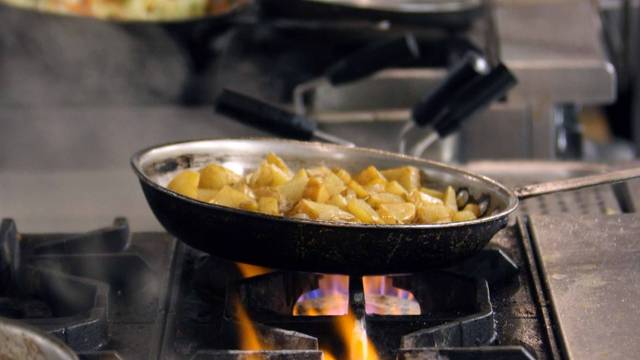Asian Restaurant ISB: A Must-Try Place for Food Lovers in Islamabad
Asian Restaurant ISB: A Must-Try Place for Food Lovers in Islamabad
Blog Article
Savor Authentic Oriental Food With a Pan-Asian Twist for a Cooking Journey
Starting a culinary trip via authentic Eastern food, improved with a Pan-Asian spin, offers an unique chance to check out the abundant tapestry of tastes that specify the area's diverse culinary practices. This experience invites you to appreciate the beautiful equilibrium of preferences-- pleasant, salty, spicy, and sour-- balanced by fragrant herbs and spices. Visualize the innovative combination of Thai curry and ramen or the unexpected pleasure of sushi burritos. As you contemplate these enticing dishes, take into consideration the cultural narratives and historic impacts that shape them, each bite providing a story waiting to be found.

Checking Out Pan-Asian Flavors
In the world of worldwide gastronomy, Pan-Asian cuisine sticks out for its amazing diversity and the unified interplay of flavors from numerous Eastern cultures. This culinary approach commemorates the unique ingredients and rich customs discovered across the continent, producing a tapestry of preferences that is both appealing and enjoyable. Trick to Pan-Asian food is its capability to stabilize contrasting tastes-- sweet, salty, spicy, and sour-- while highlighting the quality and top quality of each ingredient.
From the umami-rich soy sauce of Japan to the fiery chili peppers of Thailand, Pan-Asian cuisine uses a comprehensive scheme of tastes. These components are typically incorporated in creative means, enhancing recipes with layers of complexity. For instance, the use of fragrant natural herbs such as lemongrass and cilantro, typical in Vietnamese and Thai cuisine, includes a rejuvenating brightness to recipes, while the incorporation of coconut milk delivers a creamy, rich texture.
The focus on fresh fruit and vegetables and aromatic seasonings guarantees that each dish is not only a feast for the taste buds yet additionally for the detects. Pan-Asian cuisine invites diners to embark on a culinary trip, exploring the huge and differed landscapes of Eastern gastronomy with every bite.
Fusion Recipes to Try
While Pan-Asian food is celebrated for its traditional tastes, the modern cooking landscape is increasingly embracing fusion recipes that mix these timeless components with impacts from various other regions. This cutting-edge strategy not just honors the rich heritage of Eastern cookeries yet likewise introduces novel preference experiences that appeal to modern tastes buds.
A prime instance of such a blend recipe is the Korean-Mexican taco, where seasoned bulgogi beef is covered in a warm tortilla, covered with kimchi and a spicy gochujang-infused salsa. This mix weds the bold, savory tastes of Korea with the lively, fresh elements of Mexican food. In a similar way, sushi burritos have actually obtained appeal, joining together the delicate artistry of Japanese sushi with the hearty, hand-held comfort of a burrito, commonly featuring blend active ingredients like tempura shrimp and avocado with a drizzle of wasabi mayo.
One more notable recipe is Thai curry ramen, which instills the luscious, fragrant spices of Thai curry into the soothing brew of conventional Japanese ramen, producing a harmonious mix that tantalizes the senses. These fusion dishes expand beyond mere novelty; they represent a culinary discussion between cultures, motivating exploration and technology in the world of Pan-Asian food.
Necessary Components and Seasonings
To genuinely value Pan-Asian food, one should recognize the crucial components and flavors that form its structure. This varied cooking design attracts from a rich tapestry of Oriental traditions, employing an unified mix of tastes and appearances. Key active ingredients include soy sauce, fish sauce, and oyster sauce, which impart a tasty umami deepness important to Asian dishes. Corresponding to these are rice vinegar and mirin, lending a delicate acidity and sweetness.
Fragrant aspects are pivotal, with ginger, garlic, and lemongrass being ubiquitous throughout various Pan-Asian dishes. These components offer a great smelling base that enhances the complexity of tastes. Seasonings such as star anise, cardamom, and cinnamon present warmth and personality, resembling impacts from regions like China and India.

Food Preparation Techniques and Tips
Mastering the art of Pan-Asian cuisine requires knowledge with its distinct food preparation strategies, each adding to the lively tapestry of tastes this cooking practice is celebrated for. Central to these techniques is the stir-fry, a quick food preparation method that preserves the nutritional look at this site integrity and dazzling colors of components. Utilizing a frying pan, the stir-fry method permits even heat circulation, important for attaining the particular appearance and flavor equilibrium of Pan-Asian recipes.
Another essential technique is steaming, specifically prevalent in Chinese food. This gentle approach preserves the natural flavors and nutrients of ingredients, making it suitable for seafood and veggies. Dumplings, a beloved staple, frequently take advantage of steaming, leading to soft, delicious structures.
Grilling, likewise integral, imparts great smoky depths to recipes such as Oriental bulgogi or Japanese yakitori (asian fusion restaurant). This technique frequently involves seasoning components, allowing flavors to permeate deeply prior to food preparation over an open fire or warmer
Finally, understanding the art of stabilizing tastes-- wonderful, sour, salted, bitter, and umami-- is vital. Appropriately layering these components can boost a recipe from average to extraordinary, offering a complicated and satisfying culinary experience that symbolizes the significance of Pan-Asian food.
Dining Experiences Worldwide
Around the world, Pan-Asian cuisine supplies an unequaled eating experience, commemorated for its abundant tapestry of tastes and dynamic discussions. This culinary sensation has actually gone beyond cultural boundaries, recording the hearts and tastes of food enthusiasts worldwide. In multicultural cities like New York, London, and Sydney, Pan-Asian restaurants work as melting pots where cooking traditions from Thailand, Japan, China, and beyond merge, giving restaurants with an eclectic mix of meals that highlight the region's variety.
The worldwide allure of Pan-Asian food depends on its capability to provide both credibility and development. Chefs masterfully wed typical components such as lemongrass, soy sauce, and miso with contemporary techniques, resulting in recipes that are both familiar and refreshingly brand-new. This fusion enables diners to embark on a culinary journey that respects heritage while embracing modernity.
Additionally, eating experiences are raised through attentively designed environments that reflect the values of Pan-Asian looks. From minimalist Japanese-inspired interiors to vibrant Thai-themed spaces, each dining establishment provides a special atmosphere that matches the cooking offerings. Because of this, clients are not merely eating a meal however partaking in a social experience, making Pan-Asian eating a truly worldwide sensation.
Final Thought
The exploration of Pan-Asian cuisine uses a profound understanding of the detailed interaction of tastes and cooking practices across Asia. By accepting blend recipes such as Thai curry ramen and sushi burritos, the cooking trip not just highlights the versatility of traditional components however also showcases cutting-edge modern methods. This gastronomic journey, improved by cooking methods and crucial flavors, provides an one-of-a-kind possibility to value the multiculturalism and culinary artistry that define Pan-Asian cuisine on a global scale.
Getting started on a culinary trip with authentic Oriental cuisine, improved with a Pan-Asian twist, uses a distinct opportunity to check out the abundant browse around here tapestry of flavors that define the region's varied cooking traditions.In the realm of global gastronomy, Pan-Asian food stands out for its remarkable variety and the unified interplay of tastes from various Eastern societies. Trick to Pan-Asian food is its capability to balance different flavors-- why not find out more pleasant, salted, spicy, and sour-- while highlighting the quality and top quality of each ingredient.

Report this page